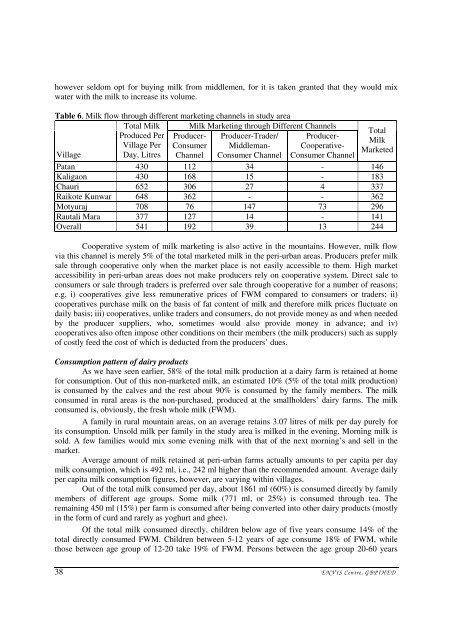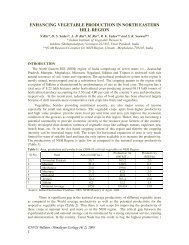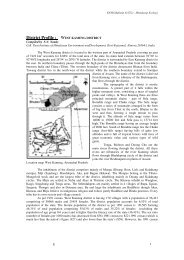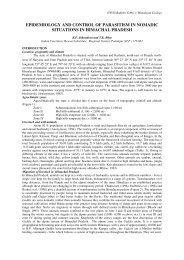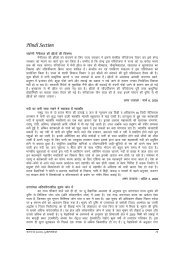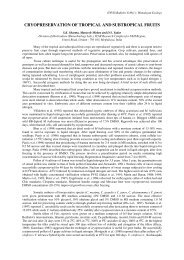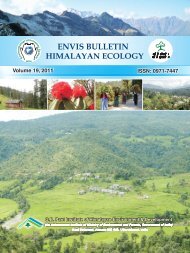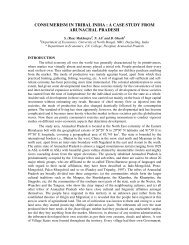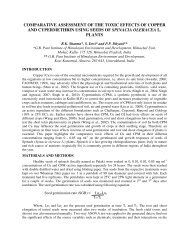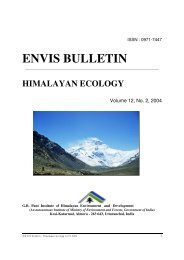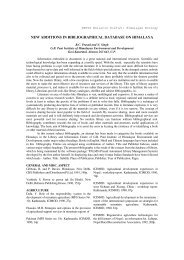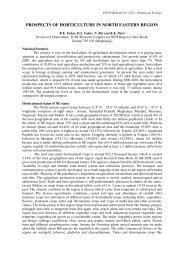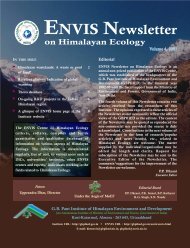Envis bulletin vol 12 1 - ENVIS Centre on Himalayan Ecology
Envis bulletin vol 12 1 - ENVIS Centre on Himalayan Ecology
Envis bulletin vol 12 1 - ENVIS Centre on Himalayan Ecology
You also want an ePaper? Increase the reach of your titles
YUMPU automatically turns print PDFs into web optimized ePapers that Google loves.
however seldom opt for buying milk from middlemen, for it is taken granted that they would mix<br />
water with the milk to increase its <str<strong>on</strong>g>vol</str<strong>on</strong>g>ume.<br />
Table 6. Milk flow through different marketing channels in study area<br />
Total Milk Milk Marketing through Different Channels<br />
Village<br />
Produced Per<br />
Village Per<br />
Day, Litres<br />
Producer-<br />
C<strong>on</strong>sumer<br />
Channel<br />
Producer-Trader/<br />
Middleman-<br />
C<strong>on</strong>sumer Channel<br />
Producer-<br />
Cooperative-<br />
C<strong>on</strong>sumer Channel<br />
Total<br />
Milk<br />
Marketed<br />
Patan 430 1<str<strong>on</strong>g>12</str<strong>on</strong>g> 34 - 146<br />
Kaliga<strong>on</strong> 430 168 15 - 183<br />
Chauri 652 306 27 4 337<br />
Raikote Kunwar 648 362 - - 362<br />
Motyuraj 708 76 147 73 296<br />
Rautali Mara 377 <str<strong>on</strong>g>12</str<strong>on</strong>g>7 14 - 141<br />
Overall 541 192 39 13 244<br />
Cooperative system of milk marketing is also active in the mountains. However, milk flow<br />
via this channel is merely 5% of the total marketed milk in the peri-urban areas. Producers prefer milk<br />
sale through cooperative <strong>on</strong>ly when the market place is not easily accessible to them. High market<br />
accessibility in peri-urban areas does not make producers rely <strong>on</strong> cooperative system. Direct sale to<br />
c<strong>on</strong>sumers or sale through traders is preferred over sale through cooperative for a number of reas<strong>on</strong>s;<br />
e.g. i) cooperatives give less remunerative prices of FWM compared to c<strong>on</strong>sumers or traders; ii)<br />
cooperatives purchase milk <strong>on</strong> the basis of fat c<strong>on</strong>tent of milk and therefore milk prices fluctuate <strong>on</strong><br />
daily basis; iii) cooperatives, unlike traders and c<strong>on</strong>sumers, do not provide m<strong>on</strong>ey as and when needed<br />
by the producer suppliers, who, sometimes would also provide m<strong>on</strong>ey in advance; and iv)<br />
cooperatives also often impose other c<strong>on</strong>diti<strong>on</strong>s <strong>on</strong> their members (the milk producers) such as supply<br />
of costly feed the cost of which is deducted from the producers’ dues.<br />
C<strong>on</strong>sumpti<strong>on</strong> pattern of dairy products<br />
As we have seen earlier, 58% of the total milk producti<strong>on</strong> at a dairy farm is retained at home<br />
for c<strong>on</strong>sumpti<strong>on</strong>. Out of this n<strong>on</strong>-marketed milk, an estimated 10% (5% of the total milk producti<strong>on</strong>)<br />
is c<strong>on</strong>sumed by the calves and the rest about 90% is c<strong>on</strong>sumed by the family members. The milk<br />
c<strong>on</strong>sumed in rural areas is the n<strong>on</strong>-purchased, produced at the smallholders’ dairy farms. The milk<br />
c<strong>on</strong>sumed is, obviously, the fresh whole milk (FWM).<br />
A family in rural mountain areas, <strong>on</strong> an average retains 3.07 litres of milk per day purely for<br />
its c<strong>on</strong>sumpti<strong>on</strong>. Unsold milk per family in the study area is milked in the evening. Morning milk is<br />
sold. A few families would mix some evening milk with that of the next morning’s and sell in the<br />
market.<br />
Average amount of milk retained at peri-urban farms actually amounts to per capita per day<br />
milk c<strong>on</strong>sumpti<strong>on</strong>, which is 492 ml, i.e., 242 ml higher than the recommended amount. Average daily<br />
per capita milk c<strong>on</strong>sumpti<strong>on</strong> figures, however, are varying within villages.<br />
Out of the total milk c<strong>on</strong>sumed per day, about 1861 ml (60%) is c<strong>on</strong>sumed directly by family<br />
members of different age groups. Some milk (771 ml, or 25%) is c<strong>on</strong>sumed through tea. The<br />
remaining 450 ml (15%) per farm is c<strong>on</strong>sumed after being c<strong>on</strong>verted into other dairy products (mostly<br />
in the form of curd and rarely as yoghurt and ghee).<br />
Of the total milk c<strong>on</strong>sumed directly, children below age of five years c<strong>on</strong>sume 14% of the<br />
total directly c<strong>on</strong>sumed FWM. Children between 5-<str<strong>on</strong>g>12</str<strong>on</strong>g> years of age c<strong>on</strong>sume 18% of FWM, while<br />
those between age group of <str<strong>on</strong>g>12</str<strong>on</strong>g>-20 take 19% of FWM. Pers<strong>on</strong>s between the age group 20-60 years<br />
38<br />
E N V IS <str<strong>on</strong>g>Centre</str<strong>on</strong>g>, G B P IH E D


